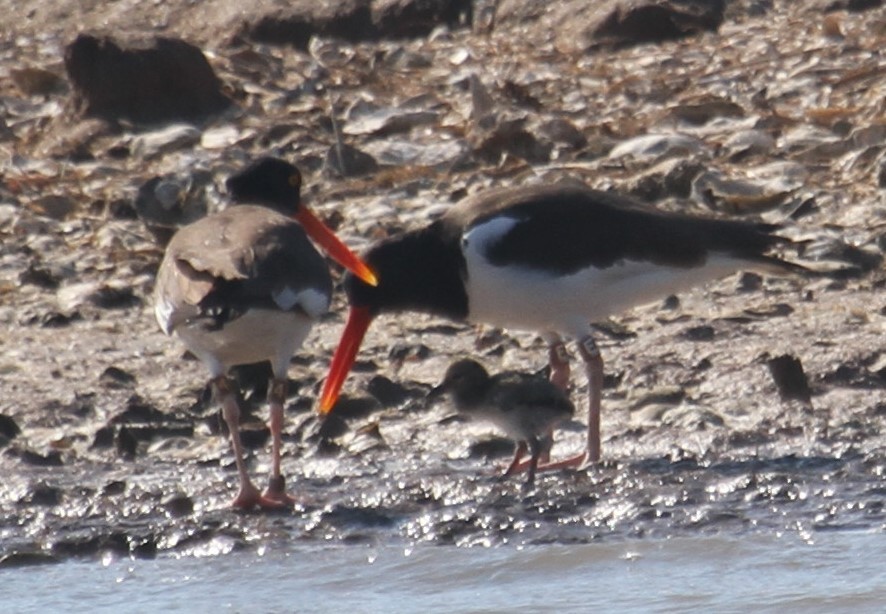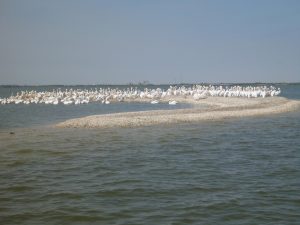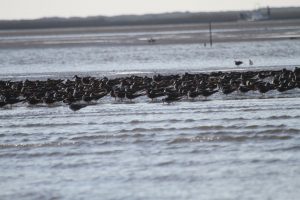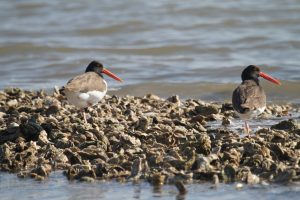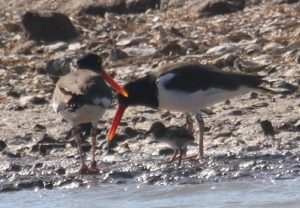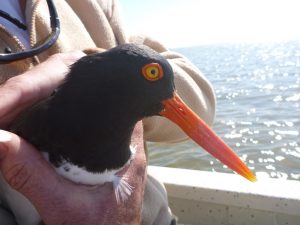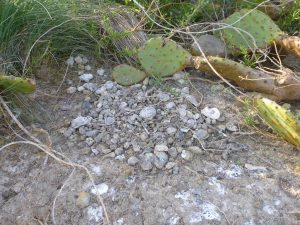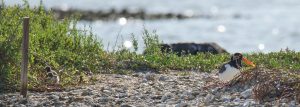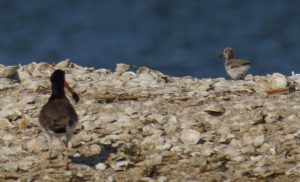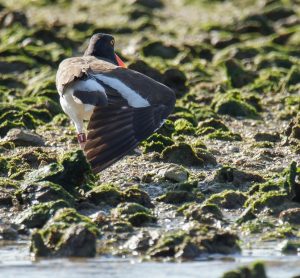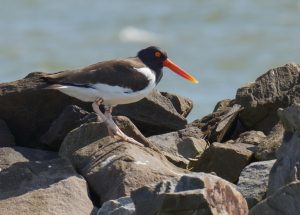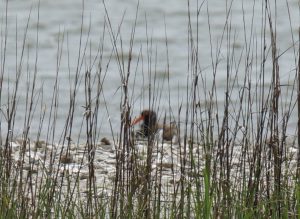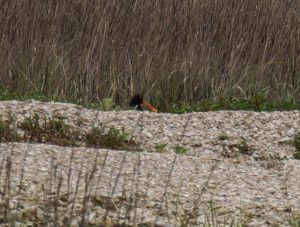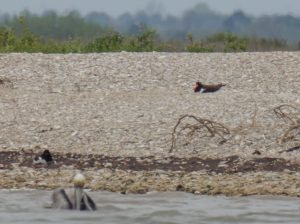By Susan Heath
On Tuesday Robin and I headed up to Dickinson Bay in hopes of trapping and banding some of the birds at the Texas City Prairie Preserve (TCPP) sand/shell spit. Two of the volunteers that monitor those birds joined us – Paula Kennedy and Joey Barnes. It’s hard for them to tell what’s going on because so many of the birds there are unbanded so we hoped to alleviate that problem. On the way out we checked on the manmade island there that is shaped like a horseshoe. Oystercatchers have nested there in the past but it has become nearly completed vegetated leaving little room for a bird that likes to nest on the ground. We found LP & unbanded there. LP is one of the infamous road warriers from last year – the pair that laid a nest along the levee road at TCPP. I suspect they tried to nest on this island first last year but failed because of the large Laughing Gull presence and that forced them to move over to the levee road. Maybe they will have better luck this year.
When we got to the sand/shell spit we found this:
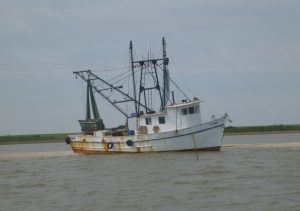 photo by Susan Heath
photo by Susan Heath
Paula said it’s been there since Hurricane Harvey and it’s too high up on the spit to be removed. That’s a lot of money sitting on a reef. We found only two oystercatchers there but they were on opposite sides of the spit so I think they were members of different pairs. One of them was showing a great affinity for a certain area so we searched for a nest but found none. We set up the whoosh net in hopes that the single bird would call its mate back when it detected the intruders (decoys). Sadly the bird flew off and we couldn’t find it. We checked the rest of the spit and went into Moses Lake and checked there. No oystercatchers anywhere. On the island in Moses Lake where there used to be pair nesting we found this.
No oystercatchers. We went back to where we’d seen the first birds but they still hadn’t returned so we sat on the boat and ate lunch. They still didn’t return so we had to give up. Crum.
On Wednesday Robin and I went out to East Matagorda Bay. We weren’t able to get out there last week so I was anxious to see what had happened to the nests there. It was a beautiful day with only a little wind. I would have preferred it to be about 10 degrees warmer though! On the way out we found a huge flock of Black Skimmers so we had to stop and gawk at them a bit.
On the Chinquapin islands we found KN & unbanded acting very much like they had a nest but we saw only a scrape. YC & unbanded were sleeping on a reef, each with a leg tucked up making it quite difficult to tell who they were.
On Dressing Point we found a single adult chasing away Laughing Gulls and no one incubating where the nest was. These are clues. Do you know what it means? I did and my heart started going pitter pat. While we watched the other adult flew in with food and I yelled to Robin to watch because the chicks would come running out to be fed. Sure enough one chick came running and was fed by his dad. Sweet!
I had only gotten a photo of one adult last week and it turned out to M4, a bird that was banded on the Chinquapin Islands in 2011. She subsequently moved over to the Boggy Creek area but never did well there. I was able to get photos of both adults this week and I discovered the male was EF a bird that attempted to nest on a very low island near Dressing Point the last few years. I’m glad they joined forces and picked Dressing Point. They have an excellent chance of fledging that chick if they can keep the gulls away.
We headed over to check the area where EF used to nest and we found an unbanded pair with a two egg nest. I set up the box and we backed off. It took a while but one of them (the male) finally went in to incubate and was trapped. We banded him LF (lefty!). He’s a handsome dude.
Then we headed over to the Oyster Farm. Our plan was to use the whoosh net to trap KT & unbanded so we could band the unbanded one and take the transmitter off KT. We set up the net and as soon as I started the oystercatcher call, they flew over. Sadly that’s all they did. Fly over. And fly over. And fly over. They never landed near the net or the decoys. We tried a couple of things to get them engaged with the decoys but they wouldn’t go for it so we had to give up.
The other pair in that area was sleeping the day away so we headed over to Old Gulf Cut. I was hoping 17 & unbanded’s nest would be hatched but they were still incubating so we checked on 25 & unbanded. Their nest was so low I figured it would be overwashed and sure enough it was. We headed down the GIWW to the boat ramp.
On Thursday I headed out to West Galveston Bay. Alan and I got our wires crossed on volunteers and Stennie who was supposed to go with us got sick so it was just Alan and I. We only saw one member of the pair by the boat ramp feeding on a reef by the middle island. This time of year, seeing only one bird when you know there’s a pair is a dead giveaway that the other one is on a nest. While we watched the other one suddenly appeared from nowhere on the island. We anchored and I followed a reef line to the island. There on the backside of the island next to a cactus was a single oystercatcher egg.
It’s pretty high up so maybe they will be successful there as long as they stay out of the cactus! We tried to head up to Swan Lake but the railroad bridge was down so we went to check Struve Luci which is near there. These birds are very wise to our ways and we have a hard time figuring out what they are doing. There had been four nests and last time we suspected at least two had hatched. This time only L8 & L9 were still incubating. HM was down by the water’s edge and his mate X& was standing up by the vegetation. Clues again. Alan’s photo revealed two chicks!
Around the other side of the island 12 & unbanded were out feeding on a reef. I suspected they had a chick so we stopped and watched. Sure enough one of them ran up to the shell ridge with food and I saw a chick up there. The adult noticed us watching before it got there though and stopped before it reached the chick. The chick ran over the ridge and down the other side where we couldn’t see it but Alan’s fabulous photo skills captured this:
Ha! We know you have a secret! We decided the other nest had failed and in fact we may have determined the owners of it incorrectly. We trapped LT on the nest so we know it was his but we thought his mate was KR. Today JA was hanging out with LT and KR was hanging out with the unbanded bird that we thought was JA’s mate. Did they switch or did we get it wrong? No telling! The soap opera continues in the oystercatcher world. LT was doing a little yoga.
The railroad bridge was up so we headed up to Swan Lake. Nothing exciting on the way up there – both pairs were working on scrapes but hadn’t laid eggs. I thought K7’s nest would be hatched but it wasn’t. In the next territory we found one unbanded bird. We searched from the boat but did not see a bird on a nest so we went to check on the next pair. They weren’t there so we turned around to head over to check the breakwaters. Suddenly we heard a ruckus and saw two oystercatchers chasing another one. Then two more joined the fray and there were five. They had an aerial battle and then two of them flew back where we had seen the single unbanded bird, two of them flew over by where we were (the pair that belonged there) and the single bird flew over to the breakwater. We went to check and see who had flown back to where we saw the single unbanded bird. There had been an unbanded pair there earlier in the season so imagine our surprise when we found 39 accompanying the unbanded bird. 39 has been paired with L5 for four or five years two territories over but has never fledged a chick because of coyote predation. I guess she finally decided to move up in the world. We went over to the breakwater to check out the bird that the others chased off and we found L5 all alone. Poor guy.
We headed back down to West Galveston Bay and discovered the nest on Jigsaw that we attributed to YE & unbanded probably belongs to T5 & T6. Along the Galveston Island shore 16 & unbanded were standing together on the shell bank but not by their nest. We had hopes they had chicks but they flew out to the reef and I saw them copulate. I don’t think they’d be doing that if they had chicks already! We didn’t find any birds on the docks along Sportsman Road. We found five birds at Gangs Bayou and one might have been on a nest but it was in an area we can’t get to so we’ll have to wait and watch from afar.
We made a brief foray down to Galveston Island State Park but the tide was too low for us to get to the oystercatcher habitat there so we came back and checked out Confederate Reef. We found three youngsters from last year along with XA and E7 hanging out there. E7 disappeared from Jigsaw a coupl years back. I’d sure like to know where she’s breeding now. On South Deer KK & unbanded and LL & unbanded were both incubating their nests. Y7 & unbanded and 13 & unbanded were both out on reefs so they still have laid any eggs yet. JN was hanging out on a reef which means UW was the one trying to hide from us on the nest.
Around the corner we saw HL on a reef but no sign of L4. You know what that means! I searched the shell ridge in my binoculars and spotted L4 on a nest. We headed over towards North Deer and checked on J6 & UF on the way. There was only one bird there and we didn’t see another one on a nest. Then I noticed that the one bird had a C in its band code. It was not J6 or UF, it was XC. J6 & UF must have realized that about the same time we did because they came zooming over and chased off XC with no questions asked. Nothing was happening with the other pairs in that area until we reached HO & JC’s territory. This is what we saw.
Ding, ding, ding! JC finally laid some eggs. No sign of the next pair there 28 & AP so we headed over to check on P3 & unbanded in Jones Bay. At first we didn’t see either of them and then I spotted one of them trying to hide behind a post. Good luck buster. We approached and suddenly the other one was there too. More clues people! I went up and found two beautiful and well camouflaged eggs right next to a cactus. What is it with the oystercatchers laying their nests by cacti? If I had to sit on eggs for hours on end every day and night, I would not want to be right next to a cactus! That just seems like asking for trouble. But that’s just one more way the birds show me that I don’t think like an oystercatcher.
We are adopting out pairs of birds again this year as fund raiser for this project. We greatly appreciate all who have adopted pairs in the past! If you aren’t familiar with the program – you can adopt a pair of oystercatchers for a $100 donation and I will update you monthly on their progress throughout the breeding season. Most pairs are from West Galveston Bay, but there is a pair from Dickinson Bay and a pair from Swan Lake too. If you want a pair from East Matagorda Bay let me know.
Current Stats for upper Texas coast from Dickinson Bay to East Matagorda Bay: 13 nests being incubated, 3 failed nests, 3 nests with unfledged chicks, 0 nests with undetermined status, 0 chicks fledged
This project is supported by the National Fish and Wildlife Foundation and several private donors. If you would like to contribute you can call our office for information on how to do so (979-480-0999). All donations are tax deductible and GREATLY appreciated.
Note: All trapping and banding for this project is in accordance with federal and state permits issued to Susan Heath, GCBO Director of Conservation Research. Bird handling by volunteers is only permitted in the presence of Susan Heath and volunteers are trained in proper bird handling techniques.

